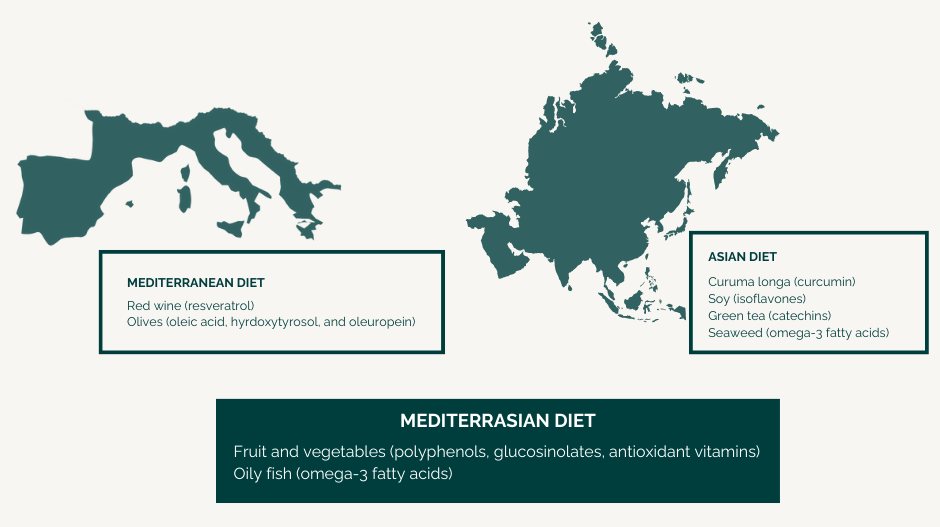What do Pippa Middelton, Adele and UFC champion Conor McGregor have in common? Besides that they are all beautiful, rich and famous they all have claimed to follow the Sirtfood diet. This diet, popularized by celebrity nutritionists Aidan Goggins and Glen Matten, has become the latest dieting trend. However, the question remains: is there sufficient clinical evidence to support its effectiveness?
In our previous post we introduced sirtuins- a group of enzymes that actively participate in a variety of physiological functions within our bodies. Here we wanted to discuss ways to modulate the expression of sirtuins naturally, focusing on diet and in particular the trendy Sirtfood diet (from sirtuins or SIRTS). In our upcoming post we will discuss the impact exercise can have on the expression of sirtuins.
Diet’s effect on sirtuin expression
Diet has been one of the most effective interventions for improving health. Here, we will examine how different diet approaches affect sirtuin expression.
Caloric restriction
Eating less but still getting the right nutrients (caloric restriction without malnutrition) could be a great way to slow down the start of many age-related diseases (1). Short-term caloric restriction after switching from standard nutrition in mice contributes to increased levels of all seven sirtuins. It has also been suggested that caloric restriction reduces the telomere shortening in various mouse tissues (2). Telomeres are the endings of the DNA that get shorter as we age. Telomere attrition is considered one of the hallmarks of aging . The increasing activity of sirtuins stabilizes telomeres and alleviates telomere-related disorders. Caloric restriction, however, is difficult to follow long term.
Fasting
Since it is not practical for most people to count calories long term, scientists looked at other ways to activate sirtuins through diet. One such way is fasting (if you are curious to know more about intermittent fasting check out our earlier post). Studies in humans suggest that sirtuins can be activated by fasting and bring positive effects in insulin response, protecting against damage (antioxidant defense), and the way we use sugar for energy glycolysis (3).
The Sirtfood diet
The Sirtfood diet could be classified as a caloric restriction diet but we wanted to place it in its own category due to the recent buzz and controversies surrounding it (4).
Sirtfood is a novel dietary approach that combines specific foods which contain compounds that activate SIRTs. Examples of such compounds are groups of chemicals like polyphenols, glucosinolates, omega-3 fatty acids and antioxidant vitamins. More specifically compounds such as resveratrol, piceatannol, anthocyanidin, and quinine are thought to influence SIRTs. Supporters of Sirtfood diet think that incorporating these natural ingredients into recipes can bring about meaningful health benefits.
How it all started?
The first time “SIRTfoods” were used as a term was in 2013 (5). Nutritionists studied the diets of people living in Blue Zones- places in Earth where people seem to life longer than the rest of the world, i.e specific regions in Asia (i.e. Japan) and Mediterranean. The Asian and Mediterranean diets are rich in fruit, vegetables, and fish thereby providing high amounts of “healthy” groups of chemicals such as polyphenols, omega-3 fatty acids and antioxidant vitamins. The so-called “MediterrAsian” diet combines sirtuin-activating foods (= SIRTfoods) of the Asian as well as Mediterranean diet. It is mostly consisting of a significant portion of plant-based low dense energy foods and a small portion of non plant-based components (5). Later two, now well-known nutrititionists, popularized the concept by publishing a book including a 3 week long calorie restricted meal plan, and recipes, called The Sirtfoods™ (6). The Sirtfood diet is based on the MediterrAsian diet, but it is more restrictive. The authors suggest that the diet is “stimulating rejuvenation and cellular repair” which sounds quite intriguing (6).

Figure 1: Important foods and their corresponding constituents in the Mediterranean and Asian diets, and the so-called MediterrAsian diet (adopted from (5))
There are certain foods that are recommended to be consumed when following the SIRT diet. The Sirtfoods™consists of recipes using fruits and vegetables.
The top 20 Sirtfoods™ are (4):
- Vegetables – arugula (rocket), bird’s eye chili, kale, onions, parsley, lovage, red chicory, and turmeric
- Fruits – strawberries, blueberries, capers, Medjool dates
- Grains – buckwheat, cereals
- Drinks – coffee, matcha green tea, red wine
- Legumes – soy
- Nuts – walnuts
- Other foods- dark chocolate (85% cocoa), extra-virgin olive oil
Controversy around the Sirtfoods™
These are all very healthy foods but the diet has since received a backlash from the scientific communities. Why? What is the science and clinical evidence behind it?
The first concern regarding Sirtfoods™ is that the authors claim that besides weight loss, the diet can turn on your “skinny gene,” and prevent diseases (7). However, there is not enough clinical evidence to back up this claim. Additionally, there is not much clinical evidence to support that Sirtfoods™ is better compared to any other caloric restriction diet. Although, the list of foods proposed have many health benefits, there are no long-term human studies done to support the claims of the authors.
The authors based their claims on a pilot study that they carried out on 39 participants in their London fitness center (7). The participants were placed on the Sirtfoods™ diet (1000–1500 cal/day) and exercise for 1 week. They lost on average 3.2 kg and maintained or regained muscle.
Although that may seem impressive there are many issues with the study design that should be addressed. The study was not published in a peer reviewed journal and the end points were not clear (7). Additionally, the study was not randomized, did not include a control group, and was of small size. There was also no long-term monitoring.
It is not surprising that the participant lost weight as that it the outcome of a caloric restriction and exercise. When the calories consumed are fewer than the calories burned, the result is weight loss. Also, in the first week of extreme caloric restriction about 2/3 of the weight loss comes from water, muscle and glycogen, where 1/3 comes from fat. As soon as the caloric restriction is removed the body replenishes glycogen levels and the weight comes back. As there was no reported follow-up after a week, the long term effects of the diet are unknown. As far as preventing diseases, a few weeks are probably not enough for long term benefit.
Some have also expressed that the ”narrow” nutrient profile or low-calorie diet (1000–1500 cal/day) and absence of other essential nutrients may cause hunger or malnourishment (4). It has been also noted that the diet is not recommended for people with eating disorders, diabetes, and athletes.
Difficulties in studying diet effects
In conclusion, increasing the sirtuins expression are promising strategy to target aging in humans as their increased expression in different models leads to increased lifespan. Although many questions remain, it is exciting to see the progress in the area of sirtuins.
Unfortunately, it can be challenging to study how diet influences health. The bioactive compounds, such as polyphenols, glucosinolates, omega-3 fatty acids and vitamins, are found in the foods in low doses when compared to the doses used in cell culture or fed in animal studies. The bioactive compounds are also metabolised before and after adsorption from the gastrointestinal tract and could work together or against other bioactive compounds found in the foods. It is thus very difficult to extrapolate findings from in vitro and in vivo experiments to humans (5).
What if we could receive these beneficial compounds in higher concentrations, similar to animal models? Pharmaceutical companies have already considered this. One of the most popular supplements on the market is resveratrol, which will be the focus of an upcoming post. But until then, what other natural methods can boost sirtuin expression? One common approach is exercise. Discover how it can be utilized in our upcoming post.
References
- Maldonado M, Chen J, Duan H, Huang T, Jiang G, Zhong Y. High calorie diet background alters the expression of sirtuins in the testes of mice under caloric restriction. Transl Med Aging. 2021 Jan 1;5:10–6.
- Vera E, Bernardes de Jesus B, Foronda M, Flores JM, Blasco MA. Telomerase Reverse Transcriptase Synergizes with Calorie Restriction to Increase Health Span and Extend Mouse Longevity. PLoS ONE. 2013 Jan 22;8(1):e53760.
- Zhu Y, Yan Y, Gius DR, Vassilopoulos A. Metabolic regulation of sirtuins upon fasting and the implication for cancer. Curr Opin Oncol. 2013 Nov;25(6):630–6.
- Sirtfoods: New Concept Foods, Functions, and Mechanisms – PMC [Internet]. [cited 2023 Aug 18]. Available from: https://www.ncbi.nlm.nih.gov/pmc/articles/PMC9563801/
- Pallauf K, Giller K, Huebbe P, Rimbach G. Nutrition and Healthy Ageing: Calorie Restriction or Polyphenol-Rich “MediterrAsian” Diet? Oxid Med Cell Longev. 2013;2013:707421.
- Goggins A, Matten G. The Sirtfood Diet. Simon and Schuster; 2017. 272 p.
- Haines M. Is there really any science behind the Sirtfood Diet? The Conversation [Internet]. 2016 Feb [cited 2023 Aug 24]; Available from: https://theconversation.com/is-there-really-any-science-behind-the-sirtfood-diet-52993



